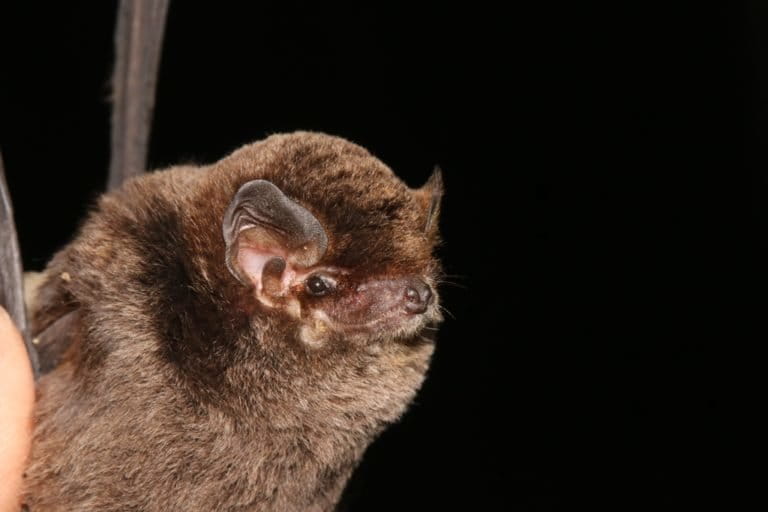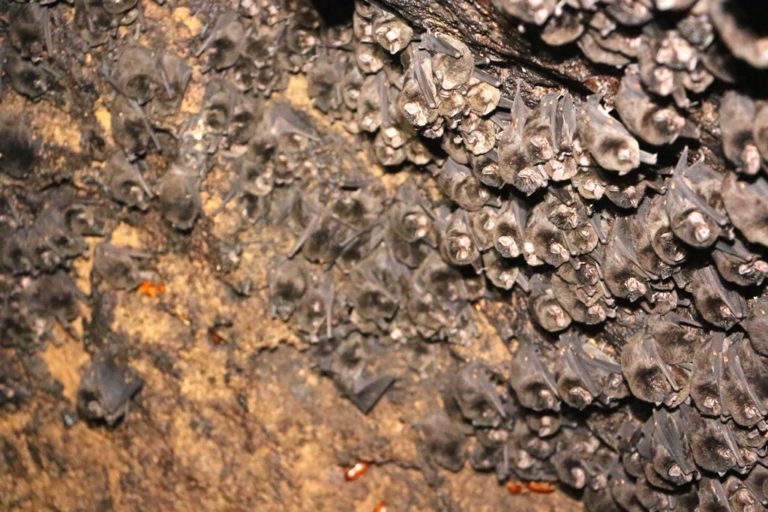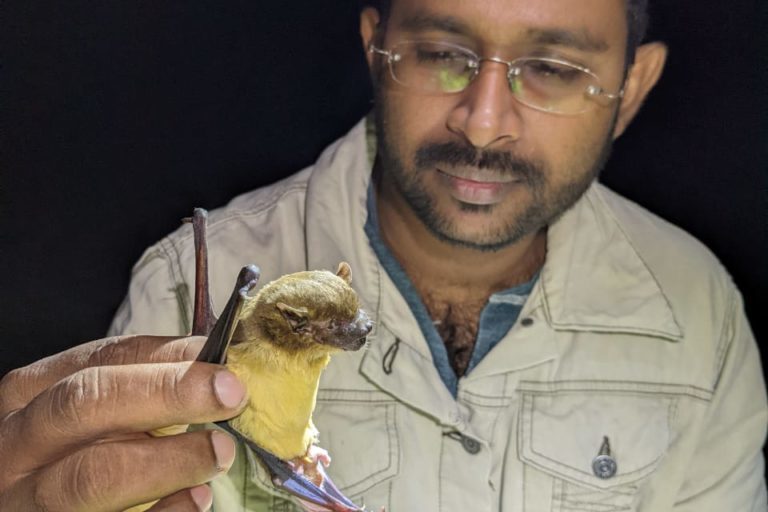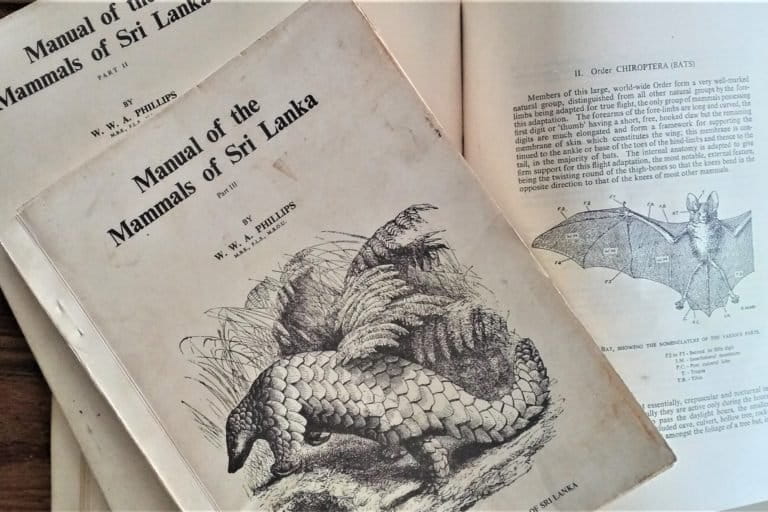- Researchers describe a new bat species found in Sri Lanka and South India and name it Miniopterus phillipsi in honour of British naturalist W.W.A. Phillips.
- Sri Lanka is home to 31 species of bats, but researchers say there could be more given that neighboring India has 132 bat species already described.
- The number of identified species in the genus Miniopterus has doubled in Africa, but in Asia, M. phillipsi is the first new addition to this genus after a lapse of six decades.
- M. phillipsi is a small, insectivorous bat previously identified as Miniopterus fuliginosus; it inhabits caves and its population remains stable, although habitat loss may soon impact these bats.
The 18th and 19th centuries’ Sri Lanka saw many British naturalists studying the island’s rich biodiversity. They also contributed to profiling the same. One of them, W.W.A. Phillips, a tea planter who was particularly interested in mammals, published the Manual of the Mammals of Sri Lanka in 1932. One of the chapters in the book describes the island’s bat fauna, including the Sri Lankan woolly bat (Kerivoula malpasi), a species then new to science.
Now, after 90 years since Phillips’ discovery, young researcher Tharaka Kusuminda, a PhD candidate at the University of Ruhuna, and his team have described a new bat species from Sri Lanka, naming it Miniopterus phillipsi in honour of the British naturalist. Their findings are reported in the journal Acta Chiropterologica.

The new bat is a medium-sized cave-dwelling insectivorous species found in Sri Lanka and India. It was previously misidentified as the Eastern bent-winged bat (Miniopterus fuliginosus), but the new species is generally smaller than M. fuliginosus in both external and skull dimensions. The newly described species does not change the total number of bat species of Sri Lanka, which remains at 31 since the entire population of M. fuliginosus would now be identified as M. phillipsi, says Kusuminda.
“M. fuliginosus is described based on a type specimen collected from a colder region in Nepal, so I had doubts whether the species found in Sri Lanka could be the same”, Kusuminda tells Mongabay. The researchers analysed the available specimen and compared DNA barcoding, which provided conclusive results proving their finding to be of a new species.

Read more: As the climate crisis deepens, Indian scientists call for the conservation of caves
Distinct species
The bats belonging to the genus Miniopterus have a special feature in which they can fold back their long third finger when their wings are folded. Sri Lanka also has a bat belonging to this genus known as the common bent-wing bat (Miniopterus schreibersii). Their wings are usually narrow, long, and more than two times the head and body, enabling them to fly at high speed.
Miniopterus is the only genus of the family Miniopteridae, which contained 19 species as recently as 2005. But genetic studies in the last few years doubled that number mainly with new bat members from Madagascar and other regions in Africa. However, M. phillipsi is the first description of a new Miniopterus species from Asia in six decades, and the first from India and Sri Lanka in nine decades.
The discovery of the new Miniopterus species again highlights the widespread existence of cryptic diversity in bats that needs to be explored using an array of modern techniques like DNA barcoding, among others, says Uttam Saikia of the Zoological Survey of India and an author of the same study.
The discovery of the new bat increased the number of bat species in India to 132, as M. fuliginosus populations are also thought to inhabit the colder northern Himalayan range. “The exact geographic boundary of both the species in India is not clear yet, but the bats previously thought as M. fuliginosus in peninsular India would actually be M. phillipsi,” Saikia tells Mongabay.
Sri Lanka is home to three fruit bat species (Megachiroptera) and 28 insectivorous-carnivorous bats (Microchiroptera), “Comparing the number of other species found in India and Sri Lanka, there is a huge difference in the number of bats, so it is likely there are much more species yet to be identified,” says Wipula Yapa of the University of Colombo. Yapa, who carried out an islandwide field survey of bats in 1995, says there are many challenges when it comes to studying bats.


Difficult species to study
“Until now, most of the species identification was done by physical features, but many species look identical, so using the molecular techniques would bring more clarity to distinguish species,” Yapa tells Mongabay. The most common bat species that many Sri Lankans would have seen is the large fruit bat known as the Indian flying fox (Pteropus medius) previously known as Pteropus giganteus, which is seen in the skies when roosting in large numbers. “Even this could be a different species or a subspecies, so we are planning to study them in the future,” Yapa tells Mongabay.
The bats of the genus Miniopterus have specific breeding habits where they use a certain cave as a nursery roost, so they migrate toward that cave — in some instances, travelling for over 150 kilometers (93 miles), Yapa says. During his survey, Yapa also observed M.phillipsi (at the time known as M.fuliginosus) using the famous Vavulpane cave in Sabaragamuwa province as a nursery roost.

The researchers studied another cave about 30 kilimeters (19 miles) away from the Vavulpane area, which was inhabited by five species of bats. All other species had bat pups, but the pregnant M.Fuliginosus tends to disappear at the height of their pregnancy. Yapa and the team tagged two such pregnant bats that were later found inside the Vavulpane cave, providing evidence of their migration pattern.
This highlights the importance of protecting the existing cave habitats, as some of them are critical for the survival of some species, says Yapa. Kusuminda also says that even the large fruit bats that are still common in cities could decline as the large trees they need to roost are often felled and electrocutions are on the rise.
Yapa also highlights the need to study bats in the North and East, as he missed surveying those areas due to the prevailing conflict at the time. Recently, Yapa discovered a colony of Scotophilus heathii — one of the rarest species of bats in the Pooneryn area in Sri Lanka’s North. They are rare elsewhere, but found in large numbers in the island’s Northern region, Yapa told Mongabay.

Sri Lanka and India are separated by a short distance of 30 kilometers (18.6 miles) in the north from where a large fruit bat was recorded while making a daily 50-kilometer (31-mile) flight, indicating the possibility of these larger bats crossing the Palk Strait regularly, says Yapa.
The researchers now plan to tag some of these bats in the Northern region to undertake a new and important study of the movement of bats between the two neighbouring countries.
Meanwhile, Sri Lankan researchers are also focusing on studying the viruses found in bats.
Yapa says this research has been isolated and already has led to the identification of several viruses in Sri Lankan bats, including those of the coronavirus family.
CITATION:
Kusuminda, T., Mannakkara, A., Kanishka, U.,Sergei, K., Amarasinghe, C.J., Saikia, U., Venugopal, P., Karunarathna, M., Gamage, R., Ruedi, M., Csorba, G., Yapa, W.B., Patterson, B.D. (2022). DNA barcoding and morphological analyses reveal a cryptic species of Miniopterus from India and Sri Lanka. Acta Chiropterologica, 24(1): 1-17.doi:10.3161/15081109ACC2022.24.1.001
This story was first published on Mongabay.com.
Banner image: Researchers have named the newly discovered species as Miniopterus phillipsi to honour British naturalist W.W.A. Phillips in recognition of his contribution to the study of bats in Sri Lanka. Photo by Tharaka Kusuminda.













